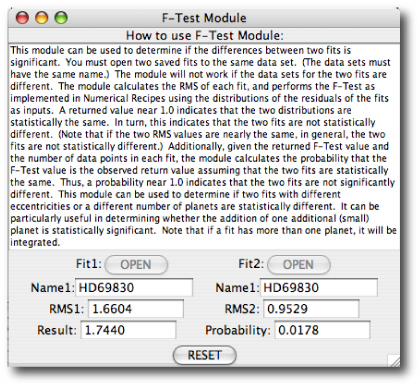
Image Source.
The discovery of new planets is rarely clear cut. No sooner does a new world (Vesta, Neptune, Pluto) emerge, than the wrangling for the credit or the naming rights starts. And it’s usually possible to find a reason why the prediction (or even the planet itself) wasn’t really valid in the first place.
The trans-Uranian planet predicted by Urbain J. J. Le Verrier and John Couch Adams happened to coincide quite closely with Neptune’s actual sky position in September 1846, but the orbital periods of their models were too long by more than 50 years. Le Verrier’s predicted planetary mass, furthermore, was too large by nearly a factor of three, and Adams’ mass prediction was off by close to a factor of two.
In England, following the announcement of Neptune’s discovery, and with the glory flowing to Le Verrier in particular and France in general, the Rev. James Challis and the Astronomer Royal George Airy were denounced for not doing enough to follow up Adams’ predictions, “Oh! curse their narcotic Souls!” wrote Adam Sedgwick, professor of geology at Trinity College.
Nowadays, with the planet count up over 200, the prediction and discovery of a new world doesn’t quite carry the same freight as it did in 1846. No editorial cartoons, no Orders of Empire, and no extravagant public praise to the discoverer, such as that heaped by Camille Flammarion on Le Verrrier, who wrote, “This scientist, this genius, has discovered a star with the tip of his pen, without other instrument than the strength of his calculations alone!”
Nevertheless, I don’t want to be shoehorned into the ranks of the “narcotic souls” as a result of not properly encouraging the bringing to light of any potential planetary discoveries in the systemic catalog of real stellar radial velocity data sets. As of Dec. 30th, 2006, over 3,680 orbital fits have been uploaded to the systemic backend. It’s definitely time to start sifting carefully through the results that the 518 registered systemic users have produced. Over the next few weeks we’ll be introducing a variety of analysis and cataloging tools that will make this job easier, but there are some interesting questions that can be answered right away. Foremost among these is: what are the most credible (previously unannounced) planets in the database?
The backend uses the so-called reduced chi-square statistic as a convenient metric for rank-ordering fits:

In the above expression, N is the number of radial velocity data points, and M is the number of activated fitting parameters. As a rule of thumb, a reduced chi-square value near unity is indicative of a “good” fit to the data, but this rule is not exact, and should hence be applied with caution. The observational errors likely depart from a normal distribution, and more importantly, the tabulated errors don’t incorporate the astrophysical radial velocity noise produced by activity on the parent star. Furthermore, it’s almost always possible to lower the reduced chi-square statistic by introducing an extra low-mass planet.
Eugenio recently implemented the downloadable console‘s F-test, which can provide help in evaluating whether an additional planet is warranted. The F-test is applied to two saved fits and returns a probability that the two fits are statistically identical. As an example, pull up the HD 69830 data set and obtain the best two planet fit that includes the 8.666-planets and 31-day planets. Save this fit to disk. Next, add the 200-day outer planet and save the resulting 3-planet fit to disk (using a separate name). Clicking on the console’s F-test button allows the F-test to be computed using the two saved fits:

In the case of HD 69830, there’s a 1.7% probability that the 2-planet fit and the 3-planet fit are statistically identical. This low probability indicates that the third planet is providing a significant improvement to the characterization of the data. It’s likely really out there orbiting the star.
So here’s the plan: Let’s comb through the systemic “Real Star” catalog, and find the systems that (1) contain an unannounced planet(s) in addition to the previously announced members of the system (see the exoplanet.eu catalog for the up-to-date list). (2) have a F-test probability of less than 2% of being statistically identical, and (3) are dynamically stable for at least 10,000 years. If you find a system that meets these requirements, post your findings to the comments section of this post.
Disclaimer: this exercise is for the satisfaction of obtaining a better understanding of the planetary census, and also for fun. When the planets do turn up, I’m going to sit back with a bottle full of bub and enjoy any scrambles for priority from a safe distance.
Happy New Year, y’all!

Posted on Systemic 1/5/07. HD50499 2 planets classified stable by the BOT. Commented F-test prob = 0.0012 that 2 planet fit is better than the published HD50499b. Stable for 10000 years by Systemic stability checker. Is this the information you need?
Hi Bruce, Absolutely!
Here are a few more:
Posted on Systemic 1/5/07. HD134987_B06 two planet fit. Consists of published HD134987b plus a 9720 day planet. F-test result = 2.4468, prob = 0.0000, stability tested for 10,000 years.
Posted on Systemic 1/6/07. HD142415 single planet improvement over published HD142415b. F-test result = 1.9287, Prob = 0.0001. No stability test run since it is a single planet. Thiessen posted a nearly identical fit on 9/1/06. This fit has the same period as the published, but mass and eccentricity differ significantly.
Posted on Systemic 1/8/07. HD177830_B06K two planet fit. Consists of HD177830b plus another planet with a 111 day period. F-test result 3.0648, prob = 0.0001, stability tested for 22,000 years.
Posted on Systemic 1/8/07. HD183263_B06K two planet fit. Consists of HD183263b plus another planet with a 3896 day period. F-test result 10.6355, prob = 0.0000. Stability tested for 10,000 years.
Posted on Systemic 1/8/07. HD183263 two planet fit. Consists of HD183263b plus another planet with a 3896 day period. Agrees well with HD183263_B06K. F-test result = 5.4317, prob = 0.0000, stability tested for 10,000 years.
HD19994 – 2 planet fit.
Published HD19994b plus a planet with a period of 35 days. F-test result = 2.0992, probability = 0.0115. Stable for 10,000 years. A fit including a planet with a period of ~35 days was first uploaded by eugenio on 6/26/06.
The criteria (2) for planet finding using the Systemic F-test needs to be restated to eliminate confusion:
“have a F-test probability of less than 2% of being statistically identical”
means the F-test result should be large enough so that the probability is 0.02 or smaller. Correct?
Hi Bruce,
Very interesting results, and sorry that I didn’t notice this earlier. We’ve been getting so much comment spam that I sometimes miss comments with actual content!
Would it be okay if I write up a couple of your finds for a front-end post? (with full credit to you, of course!)
You’re correct wrt to the statement on the F-test. The F-test result should be large enough so that the probability is 0.02 or smaller.
best,
Greg
Sure, write up anything you think interesting. May I suggest that the team aspect should be emphasized; I am just one of many users. And without the Systemic development, there would be little to report.
HD208487_B06A
Published planet HD208487b: Period 123 days, Mass 0.45 Jupiter masses, Eccentricity 0.32.
This fit:
Planet 1: Period 129.436 days, Mass 0.4601 Jupiter masses, Eccentricity 0.2840.
Planet 2: Period 873.897 days, Mass 0.4926 Jupiter masses, Eccentricity 0.2635.
Statistics: Chi^2 = 1.0556
F-test result = 3.8425, probability = 0.0001
Stablity tested for 10,000 years.
Systemic postings of a ~873 day planet:
mikevald: 1013 days on 2006-09-04, 20:22:53
dstew: 997 days on 2006-09-07, 13:24:27
greg: 980 days on 2006-09-11, 13:27:00
andy: 1000 days on 2006-09-11, 13:39:59
bruce01: 873 days on 2007-01-26, 15:40:42
HD208487
Published planet HD208487b: Period 123 days, Mass 0.45 Jupiter masses, Eccentricity 0.32.
This fit:
Planet 1: Period 129.338 days, Mass 0.4857 Jupiter masses, Eccentricity 0.2025.
Planet 2: Period 1006.670 days, Mass 0.7637 Jupiter masses, Eccentricity 0.4612.
Statistics: Chi^2 = 0.6163
F-test result = 4,7131, probability = 0.0000
Stablity tested for 17,000 years.
Systemic postings of a ~1006 day planet:
eugenio: 959 days on 2006-07-12, 22:16:43
mikevald: 1006 days on 2006-09-04, 20:22:16
mikehall: 1006 days on 2006-09-26, 13:42:59
irpoorman: 999 days on 2006-10-23, 03:02:03
bruce01: 1006 days on 2007-01-26, 15:41:08
HD216770
Published planet HD216770b: Period 118.45 days, Mass 0.68 Jupiter masses, Eccentricity 0.37.
This fit:
Planet 1: Period 118.169 days, Mass 0.6491 Jupiter masses, Eccentricity 0.3887.
Planet 2: Period 12.456 days, Mass 0.1886 Jupiter masses, Eccentricity 0.4741.
Statistics: Chi^2 = 0.6383
F-test result = 3.7618, probability = 0.0116
Stablity tested for 13,900 years.
Systemic postings of a ~12.4 day planet:
goldrake on 2006-09-19, 13:17:26
glenn on 2006-09-29, 22:21:01
EricFDiaz on 2006-09-30, 10:43:55
flanker on 2006-10-03, 11:30:07
EricFDiaz on 2006-11-11, 14:06:09
EricFDiaz on 2006-11-11, 14:06:09
flanker on 2006-11-12, 01:21:13
flanker on 2006-11-12, 01:24:04
bruce01 on 2007-01-27, 06:14:25
HD222582_B06K
Single planet fit:
Published planet HD222582b: Period 572 days, Mass 5.11 Jupiter masses, Eccentricity 0.76.
Systemic single planet fit to this data set:
Planet 1: Period 572.318 days, Mass 7.8547 Jupiter masses, Eccentricity 0.7346.
Statistics: Chi^2 = 1.7991
F-test result = 21.5919, probability = 0.0000
No stability test.
Systemic postings of a 572 day planet with mass ~7.85:
andy: 2006-08-06, 14:29:15
markk: 2006-09-27, 06:23:16
flanker: 2006-11-11, 10:32:59
khaslag: 2006-11-12. 11:43:10
Two planet fit:
Published planet HD222582b: Period 572 days, Mass 5.11 Jupiter masses, Eccentricity 0.76.
Planet 1: Period 572.727 days, Mass 7.8334 Jupiter masses, Eccentricity 0.7290.
Planet 2: Period 15.444 days, Mass 0.0513 Jupiter masses, Eccentricity 0.5632.
Statistics: Chi^2 = 1.2187
F-test result = 28.2239, probability = 0.0000
Stablity tested for 17,200 years.
Systemic postings of a ~15.4 day planet:
flanker: 2006-11-11, 10:32:59
bruce01: 2006-12-30, 16:14:41
GJ 876: 4-planets fit by EricFDiaz
Chi^2=1.27
F-Test 1.0% probability.
New Planet Data:
Period: 361.64 days
Mass: 0.06 MJup
Eccentricity: 0.09
Omega: 195.28°
My fit for GJ 876 is a bad fit. I did not understand how to properly interpret the F-test at the time, resulting in me to erroneously conclude that I had discovered a new planet. I was wrong. The actual F-test probability for this fit is 82%, meaning that there is no significant statistical difference between it and the 3-planets fit. I have to do this fit over again starting from scratch. I apologize for any confusion that I may have caused. Sincerely, Eric F. Diaz
Pingback: systemic - Relaunch